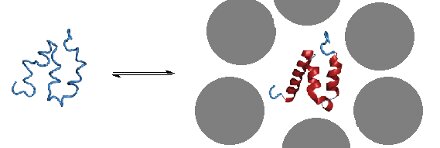Crowding Effects on Proteins

Proteins are important macromolecules in living organisms. They have diverse functions, such as enzymes, carrier proteins and structural components. A lot of diseases, such as Alzheimer’s and Parkinson’s disease, can therefore be linked to a malfunction of proteins.
Structural biology links the function of proteins to their structure. This theory seems to be contradicted by the existence of the so-called intrinsically disordered proteins (IDP’s), a class of proteins that does not seem to possess any traditional secondary structural elements. Initially neglected by structural biologists, the study of IDP’s gained interest as research determined that they are important in the explanation of protein related diseases.
Due to the lack of traditional structural elements, conventional methods used to determine the structure of proteins are not sufficient in the study of IDP’s. It is therefore that this research group uses two new physical biochemical techniques. Vibrational circular dichroism (VCD) and Raman optical activity (ROA) are two chiral spectroscopic methods, and are combined under the name vibrational optical activity (VOA). ROA is based on the Raman scattering of circularly polarized light, while VCD determines the differential absorption of circular polarized infrared light. VOA is more sensitive towards and provides more information about (non-traditional) structural elements in proteins. A further complication in the study of IDP’s can be that they could obtain different structural elements in different environments Traditional functional methods use an aqueous solution with a low concentration of the studied protein, mimicking its concentration in cellular environments. However, these methods do not take into account the high overall concentration of macromolecules in the cell. This amount of macromolecules can exclude a part of the volume for other macromolecules, forcing macromolecules with a flexible structure towards a more compact structure. This phenomenon is described in crowding theory. It is believed that IDP’s are particularly sensitive to this cellular environment.
It is the purpose of this research to test the crowding theory experimentally by means of VOA, and compare the experimental results with theoretical predictions. This should lead to a better understanding of the role of crowding in the functioning of proteins and the functioning and malfunctioning of proteins in cellular environments in general.